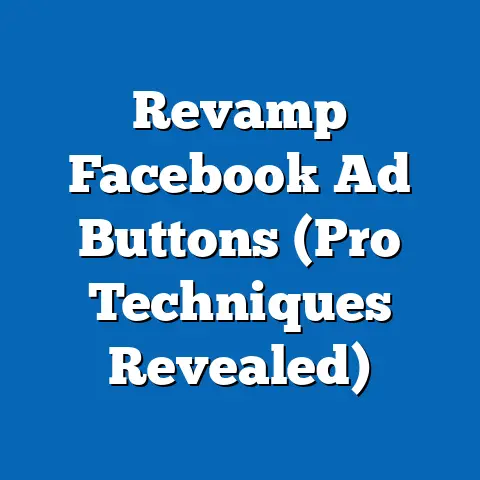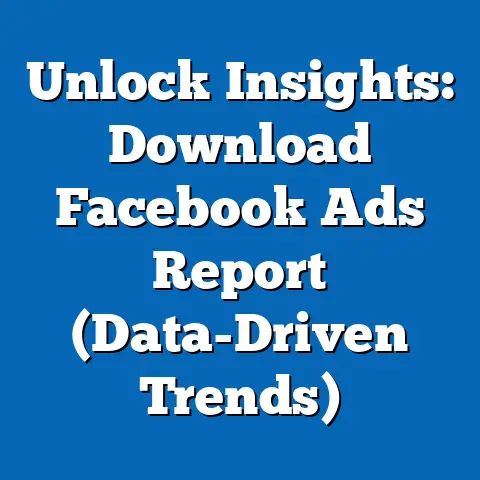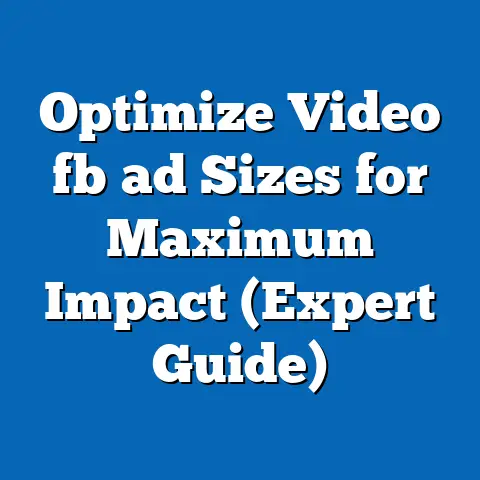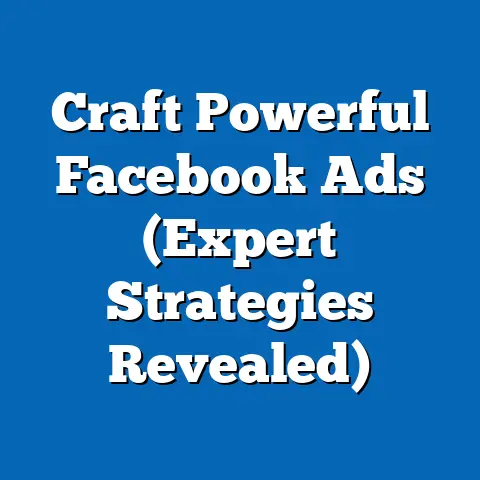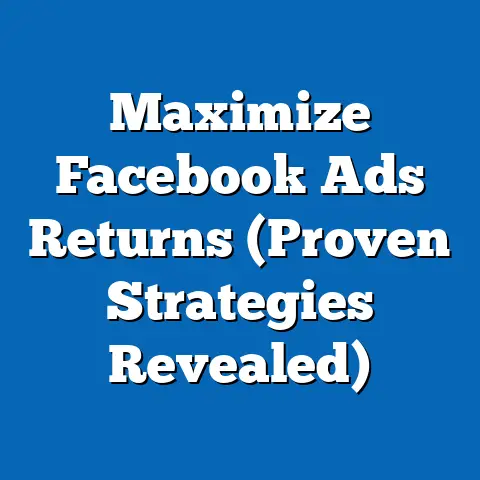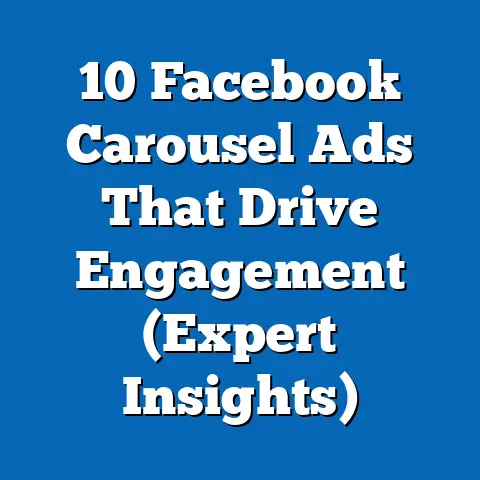Unlock Gym Growth with Facebook Ads (Proven Strategies)
The fitness industry is a force to be reckoned with. It’s seen trends come and go, weathered economic storms, and continues to evolve with the changing needs of its clientele. I’ve watched gyms transform from simple weightlifting spaces to multifaceted wellness centers offering everything from HIIT classes to nutritional counseling. But one thing remains constant: the challenge of attracting and retaining members in a competitive landscape.
In today’s digital age, simply having a great facility and knowledgeable staff isn’t enough. You need to actively reach out to potential members where they spend their time – online. And that’s where Facebook Ads come in. As someone who has worked with numerous fitness businesses, I can tell you that Facebook Ads are no longer optional; they’re a critical tool for gyms looking to grow their membership base and foster engagement with their existing community.
Think about it: according to Statista, Facebook boasts over 3 billion monthly active users. That’s a massive pool of potential gym-goers just waiting to be discovered. The key, however, lies in leveraging Facebook’s powerful advertising platform effectively.
This article is your roadmap to unlocking gym growth through proven Facebook Ads strategies. I’ll guide you through everything from understanding your target audience to crafting compelling ad content, setting up optimized campaigns, and using the Facebook Pixel for powerful retargeting. We’ll dive into measuring success, adjusting strategies, and ultimately, achieving a significant return on your advertising investment. Get ready to transform your gym’s marketing and welcome a wave of new members!
Section 1: Understanding Your Target Audience
Before you even think about crafting your first ad, you need a crystal-clear picture of who you’re trying to reach. This isn’t just about knowing their age and gender; it’s about understanding their motivations, their pain points, and what truly resonates with them.
Defining Your Audience
The success of any marketing campaign hinges on knowing your audience. For gyms, this means digging deep to understand the demographics, psychographics, and behaviors of potential members. Consider these factors:
- Age: Are you targeting young adults looking for high-intensity workouts, or older adults seeking low-impact fitness options?
- Fitness Goals: Are people interested in weight loss, muscle gain, improved cardiovascular health, or simply stress relief?
- Location: Focus on your local community. Facebook’s geo-targeting capabilities are incredibly powerful.
- Lifestyle: Are they busy professionals, stay-at-home parents, students, or retirees?
- Income Level: This can influence their willingness to pay for premium gym memberships or personal training.
- Interests: What other activities do they enjoy? Hiking, yoga, sports, healthy cooking?
I remember working with a CrossFit gym that initially struggled with their Facebook Ads. They were targeting a broad audience with generic messaging. Once we narrowed their focus to young professionals interested in competitive fitness and a strong community, their ad performance skyrocketed. They understood that their ideal member wasn’t just anyone looking to get in shape; they were targeting a specific type of individual seeking a challenging and supportive environment.
Creating Buyer Personas
Buyer personas are fictional, yet highly detailed, representations of your ideal gym members. They go beyond basic demographics and delve into the motivations, behaviors, and pain points of your target audience.
Here’s how to create effective buyer personas:
- Gather Information: Interview current members, analyze customer data, and conduct market research.
- Identify Common Traits: Look for recurring patterns in demographics, interests, and motivations.
- Create a Detailed Profile: Give your persona a name, age, occupation, and a backstory. Describe their fitness goals, challenges, and what they’re looking for in a gym.
Example Buyer Persona:
- Name: Sarah Miller
- Age: 32
- Occupation: Marketing Manager
- Background: Sarah works long hours and struggles to find time for fitness. She’s tried various diets and workout programs in the past but hasn’t been able to stick with them.
- Fitness Goals: Sarah wants to lose weight, improve her energy levels, and reduce stress.
- Challenges: Sarah is short on time, lacks motivation, and finds it difficult to stay consistent with her workouts.
- What She’s Looking For: Sarah wants a gym that offers convenient class times, a supportive community, and personalized guidance to help her achieve her fitness goals.
By creating detailed buyer personas like Sarah, you can tailor your Facebook Ads to speak directly to the needs and desires of your ideal members. You can address their specific pain points and highlight the benefits of your gym that are most relevant to them.
Utilizing Facebook Insights
Facebook Insights is a goldmine of information about your audience. It provides valuable data on the demographics, interests, and behaviors of people who interact with your Facebook page.
Here’s how to use Facebook Insights to refine your advertising strategy:
- Analyze Demographic Data: Understand the age, gender, location, and education level of your followers.
- Identify Interests: Discover the topics and pages that your audience is interested in.
- Track Engagement: Monitor the performance of your posts and ads to see what resonates with your audience.
- Audience Overlap: See how your audience overlaps with other pages or interests.
I once worked with a yoga studio that used Facebook Insights to discover that a significant portion of their audience was also interested in healthy eating and mindfulness. This led them to create ads promoting workshops on these topics, which resulted in a significant increase in enrollment.
Key Takeaways for Section 1:
- Understanding your target audience is crucial for effective Facebook advertising.
- Develop detailed buyer personas to represent your ideal gym members.
- Utilize Facebook Insights to gather data on potential customers and refine your advertising strategy.
Next Steps:
- Conduct market research to identify your target audience.
- Create detailed buyer personas based on your research.
- Analyze Facebook Insights to gain a deeper understanding of your audience.
Section 2: Crafting Compelling Ad Content
Now that you have a solid understanding of your target audience, it’s time to create ad content that grabs their attention and compels them to take action. This section will cover the key elements of effective ads, the power of storytelling, and the various ad formats available on Facebook.
Elements of Effective Ads
A high-performing Facebook ad consists of several key components working together in harmony. These include:
- Headline: The first thing people see, so make it attention-grabbing and relevant.
- Visual: A compelling image or video that captures the essence of your gym and its offerings.
- Copy: Clear, concise, and persuasive text that highlights the benefits of joining your gym.
- Call to Action (CTA): A clear and direct instruction that tells people what you want them to do (e.g., “Sign Up Now,” “Learn More,” “Get a Free Trial”).
Headline Tips:
- Use high-quality images or videos: Avoid blurry or pixelated visuals.
- Showcase real people: Feature current members working out and enjoying your gym.
- Highlight your gym’s unique features: Show off your state-of-the-art equipment, spacious facilities, or unique class offerings.
Copy Tips:
- Focus on benefits, not features: Explain how your gym can help people achieve their fitness goals.
- Use persuasive language: Highlight the value of your gym and create a sense of excitement.
- Keep it concise: People have short attention spans, so get to the point quickly.
I remember working with a personal training studio that was struggling to attract new clients. Their initial ads featured generic images of workout equipment and bland copy that simply listed their services. We revamped their ads with before-and-after photos of real clients and compelling copy that focused on the transformative results they could achieve. The response was phenomenal.
Storytelling in Ads
Storytelling is a powerful way to connect with potential members on an emotional level. By sharing stories of transformation, community, or unique offerings, you can create a lasting impression and inspire people to take action.
Here are some examples of successful gym ads that utilize storytelling:
- Transformation Stories: Showcase the journey of a member who has achieved significant weight loss or fitness gains.
- Community Stories: Highlight the supportive and welcoming atmosphere of your gym.
- Unique Offering Stories: Tell the story behind a unique class or program that sets your gym apart.
Example Storytelling Ad:
Visual: A before-and-after photo of a member who has lost weight and gained confidence.
Headline: “From Overwhelmed to Empowered: Meet [Member’s Name]”
Copy: “Sarah was tired of feeling sluggish and unhappy with her body. She joined our gym and, with the support of our amazing trainers and community, she lost 30 pounds and regained her confidence. Ready to start your own transformation story? Join us today!”
Call to Action: “Learn More”
Ad Formats to Consider
Facebook offers a variety of ad formats to suit different marketing goals and target audiences. Here are some of the most effective ad formats for gyms:
- Image Ads: Simple and effective for showcasing your gym’s facilities, equipment, or members.
- Video Ads: Engaging and attention-grabbing for telling stories and demonstrating workout techniques.
- Carousel Ads: Allow you to showcase multiple images or videos in a single ad, highlighting different aspects of your gym.
- Slideshow Ads: Create a video-like experience using a series of still images, perfect for showcasing transformations or class offerings.
- Lead Ads: Collect leads directly from Facebook without requiring users to visit your website. This is great for offering free trials or consultations.
When to Use Each Format:
- Image Ads: Best for showcasing your gym’s facilities, equipment, or members in a visually appealing way.
- Video Ads: Ideal for telling stories, demonstrating workout techniques, or showcasing the energy and atmosphere of your gym.
- Carousel Ads: Perfect for highlighting different aspects of your gym, such as various classes, equipment, or testimonials.
- Slideshow Ads: A great alternative to video ads when you don’t have video footage available.
- Lead Ads: Use these to collect leads for free trials, consultations, or special offers.
Key Takeaways for Section 2:
- Effective Facebook ads consist of a compelling headline, visual, copy, and call to action.
- Storytelling can create a strong emotional connection with potential members.
- Facebook offers a variety of ad formats to suit different marketing goals.
Next Steps:
- Brainstorm compelling headline ideas for your Facebook ads.
- Gather high-quality images and videos of your gym.
- Write persuasive copy that highlights the benefits of joining your gym.
- Experiment with different ad formats to see what works best for your audience.
Section 3: Setting Up and Optimizing Campaigns
Now that you have compelling ad content, it’s time to set up your Facebook ad campaigns and optimize them for maximum performance. This section will cover the steps for creating your ad campaign, budgeting for success, and the importance of A/B testing.
Creating Your Ad Campaign
Setting up a Facebook ad campaign involves several key steps:
- Choose Your Campaign Objective: Select the objective that aligns with your marketing goals, such as “Lead Generation,” “Website Traffic,” or “Brand Awareness.”
- Define Your Target Audience: Use Facebook’s targeting options to reach your ideal gym members based on demographics, interests, and behaviors.
- Select Ad Placements: Choose where you want your ads to appear, such as Facebook News Feed, Instagram Feed, or Audience Network.
- Set Your Budget: Determine how much you’re willing to spend on your ad campaign.
- Create Your Ads: Upload your visuals, write your copy, and add your call to action.
Campaign Objective Considerations:
- Lead Generation: Use this objective to collect leads for free trials or consultations.
- Website Traffic: Drive traffic to your website to showcase your gym’s facilities, class schedules, and membership options.
- Brand Awareness: Increase awareness of your gym within your local community.
Targeting Options:
- Demographics: Target people based on age, gender, location, education level, and relationship status.
- Interests: Target people based on their interests, such as fitness, healthy eating, sports, and outdoor activities.
- Behaviors: Target people based on their online behavior, such as their purchase history and the pages they like.
- Custom Audiences: Target people who have previously interacted with your website or social media content (more on this in Section 4).
Ad Placements:
- Facebook News Feed: The most common placement, where ads appear in users’ news feeds.
- Instagram Feed: Reach a younger audience on Instagram.
- Audience Network: Extend your reach to other websites and apps that partner with Facebook.
I always recommend starting with a specific campaign objective and a well-defined target audience. Don’t try to be everything to everyone. Focus on reaching the people who are most likely to be interested in your gym.
Budgeting for Success
Determining an appropriate budget for Facebook Ads can be tricky. It depends on several factors, including:
- Your Marketing Goals: Are you looking for rapid growth or a steady stream of new members?
- Your Target Audience Size: The larger your target audience, the more you’ll need to spend.
- Your Industry Competition: If there are many gyms in your area, you’ll need to bid more aggressively.
- Your Ad Quality: High-quality ads with compelling content will generally perform better and cost less.
Cost-Per-Click (CPC) vs. Cost-Per-Impression (CPM):
- CPC: You pay each time someone clicks on your ad.
- CPM: You pay for every 1,000 impressions (the number of times your ad is shown).
Tips for Maximizing ROI on Ad Spend:
- Start Small: Begin with a smaller budget and gradually increase it as you see results.
- Monitor Your Performance: Track your key metrics closely and adjust your budget accordingly.
- Optimize Your Ads: Continuously test different visuals, copy, and targeting options to improve your ad performance.
Industry Benchmarks:
While CPC and CPM can vary significantly based on your industry and target audience, here are some general benchmarks for the fitness industry:
- CPC: $0.50 – $2.00
- CPM: $5.00 – $15.00
These are just estimates, and your actual costs may be higher or lower depending on your specific circumstances.
A/B Testing and Optimization
A/B testing, also known as split testing, is the process of comparing two versions of an ad to see which one performs better. This is crucial for refining your ad performance and maximizing your ROI.
What to A/B Test:
- Headlines: Test different headline variations to see which one grabs the most attention.
- Visuals: Experiment with different images and videos to see which one resonates with your audience.
- Copy: Try different copy variations to see which one is most persuasive.
- Call to Action: Test different calls to action to see which one drives the most conversions.
- Target Audience: Compare the performance of different target audience segments.
How to A/B Test:
- Create Two Versions of Your Ad: Change only one element at a time (e.g., headline).
- Run Both Ads Simultaneously: Ensure both ads are running to the same target audience.
- Track the Results: Monitor the performance of both ads closely.
- Choose the Winner: Select the ad that performs better based on your key metrics.
- Repeat the Process: Continuously test and optimize your ads to improve performance over time.
I’ve seen countless campaigns transformed through diligent A/B testing. It’s not about guessing what works; it’s about letting the data guide you.
Key Takeaways for Section 3:
- Setting up a Facebook ad campaign involves choosing your objective, defining your target audience, selecting ad placements, and setting your budget.
- Determine an appropriate budget for Facebook Ads based on your marketing goals, target audience size, and industry competition.
- A/B testing is crucial for refining your ad performance and maximizing your ROI.
Next Steps:
- Set up your first Facebook ad campaign.
- Determine your budget based on your marketing goals and target audience size.
- Start A/B testing different elements of your ads to improve performance.
Section 4: Leveraging Facebook Pixel for Retargeting
The Facebook Pixel is a powerful tool that can significantly enhance your Facebook advertising efforts, especially when it comes to retargeting. This section will explain what the Facebook Pixel is, how to build custom audiences using it, and proven retargeting strategies for gyms.
What is Facebook Pixel?
The Facebook Pixel is a small snippet of code that you place on your gym’s website. It tracks user interactions on your website, such as page views, button clicks, and form submissions. This data allows you to:
- Track Conversions: See how many people who click on your Facebook ads actually sign up for a membership or free trial.
- Optimize Ads: Improve the performance of your ads by targeting people who are more likely to convert.
- Build Custom Audiences: Create custom audiences for retargeting campaigns based on website activity.
How to Install the Facebook Pixel:
- Create a Facebook Pixel: In Facebook Ads Manager, navigate to “Events Manager” and create a new pixel.
- Install the Pixel Code: Copy the pixel code and paste it into the header section of your website.
- Verify Installation: Use the Facebook Pixel Helper Chrome extension to verify that the pixel is installed correctly.
It’s crucial to install the Facebook Pixel as soon as possible, even if you’re not planning on running retargeting campaigns right away. The sooner you install it, the more data you’ll collect.
Building Custom Audiences
Once you’ve installed the Facebook Pixel, you can use it to create custom audiences for retargeting campaigns. This allows you to target people who have already shown an interest in your gym.
Types of Custom Audiences:
- Website Visitors: Target people who have visited specific pages on your website, such as your membership page or class schedule page.
- People Who Have Engaged with Your Content: Target people who have liked, commented on, or shared your Facebook or Instagram posts.
- Email List: Upload your email list to Facebook and target people who are already on your list.
- Lookalike Audiences: Create audiences that are similar to your existing customers or website visitors.
Example Custom Audiences for Gyms:
- People Who Visited the Membership Page: Target people who have shown an interest in signing up for a membership.
- People Who Watched a Video on Your Website: Target people who are interested in a specific class or program.
- People Who Abandoned the Sign-Up Form: Target people who started the sign-up process but didn’t complete it.
Retargeting Strategies
Retargeting is a powerful way to convert potential leads into members. By targeting people who have already shown an interest in your gym, you can increase your chances of getting them to sign up.
Proven Retargeting Strategies for Gyms:
- Offer a Discount or Special Offer: Entice people to sign up by offering a discount on their first month’s membership or a free personal training session.
- Highlight Testimonials and Success Stories: Showcase the positive experiences of your current members.
- Create a Sense of Urgency: Use phrases like “Limited Time Offer” or “Sign Up Today” to encourage people to take action.
- Remind People of What They Missed: Show them what they’re missing out on by not joining your gym.
Timing is Key:
- Immediate Retargeting: Target people who have recently visited your website or engaged with your content.
- Long-Term Retargeting: Target people who have been inactive for a while to re-engage them.
Example Retargeting Ad:
Visual: A photo of your gym’s facilities and happy members.
Headline: “Still Thinking About Joining? Get 20% Off Your First Month!”
Copy: “We know you’re busy, but don’t let your fitness goals fall by the wayside. Sign up for a membership today and get 20% off your first month. Join our supportive community and start your fitness journey!”
Call to Action: “Sign Up Now”
Key Takeaways for Section 4:
- The Facebook Pixel tracks user interactions on your website, allowing you to track conversions, optimize ads, and build custom audiences.
- Create custom audiences based on website visitors, engagement, and email lists.
- Use retargeting to convert potential leads into members by offering discounts, highlighting testimonials, and creating a sense of urgency.
Next Steps:
- Install the Facebook Pixel on your gym’s website.
- Create custom audiences based on your website visitors and engagement.
- Set up retargeting campaigns with compelling offers and messaging.
Section 5: Measuring Success and Adjusting Strategies
The final piece of the puzzle is measuring the success of your Facebook ad campaigns and adjusting your strategies based on the data you collect. This section will cover the key performance indicators (KPIs) that gyms should track, how to analyze ad performance using Facebook Ads Manager, and how to pivot your strategies based on performance metrics.
Key Performance Indicators (KPIs)
KPIs are the metrics that you use to measure the success of your Facebook ad campaigns. They provide insights into how well your ads are performing and whether you’re achieving your marketing goals.
Essential KPIs for Gyms:
- Engagement Rate: The percentage of people who interact with your ads (likes, comments, shares).
- Click-Through Rate (CTR): The percentage of people who click on your ads.
- Conversion Rate: The percentage of people who sign up for a membership or free trial after clicking on your ads.
- Cost-Per-Click (CPC): The amount you pay each time someone clicks on your ads.
- Cost-Per-Acquisition (CPA): The amount you pay to acquire a new member.
- Return on Ad Spend (ROAS): The amount of revenue you generate for every dollar you spend on ads.
Industry Benchmarks:
While KPIs can vary depending on your specific goals and target audience, here are some general benchmarks for the fitness industry:
- Engagement Rate: 1-3%
- CTR: 0.5-2%
- Conversion Rate: 1-5%
- CPA: $50-$150
- ROAS: 2x-5x
Again, these are just estimates, and your actual results may be higher or lower.
Analyzing Ad Performance
Facebook Ads Manager provides a wealth of data about your ad performance. You can use this data to identify what’s working and what’s not, and make adjustments to your campaigns accordingly.
How to Analyze Ad Performance:
- Log in to Facebook Ads Manager: Access your ad account.
- Select Your Date Range: Choose the period you want to analyze.
- Review Your KPIs: Examine your engagement rate, CTR, conversion rate, CPC, CPA, and ROAS.
- Identify Trends: Look for patterns in your data. Are certain ads performing better than others? Are certain target audiences more responsive?
- Segment Your Data: Analyze your data by ad, audience, placement, and other factors to gain deeper insights.
Tips for Interpreting Data:
- Focus on the Big Picture: Don’t get bogged down in the details. Focus on the KPIs that are most important to your marketing goals.
- Look for Statistically Significant Differences: Make sure that the differences you’re seeing are not just due to chance.
- Consider External Factors: Be aware of external factors that may be influencing your ad performance, such as seasonality or local events.
Adjusting Strategies Based on Data
The key to successful Facebook advertising is to adopt a data-driven approach. This means continuously monitoring your ad performance, analyzing the data, and making adjustments to your strategies based on what you learn.
How to Pivot Your Strategies:
- Optimize Your Ads: Improve the performance of your ads by testing different headlines, visuals, copy, and calls to action.
- Refine Your Targeting: Narrow your target audience to focus on the people who are most likely to convert.
- Adjust Your Budget: Allocate more budget to the ads and campaigns that are performing best.
- Experiment with New Strategies: Don’t be afraid to try new things. The fitness industry is constantly evolving, so you need to stay ahead of the curve.
I’ve seen gyms completely transform their marketing by embracing a data-driven approach. It’s not about sticking to a rigid plan; it’s about being flexible and adaptable.
Key Takeaways for Section 5:
- Track essential KPIs such as engagement rate, CTR, conversion rate, CPC, CPA, and ROAS.
- Analyze ad performance using Facebook Ads Manager to identify trends and insights.
- Adjust your strategies based on data to optimize your campaigns and achieve your marketing goals.
Next Steps:
- Set up tracking for your key performance indicators.
- Analyze your ad performance regularly using Facebook Ads Manager.
- Make adjustments to your strategies based on the data you collect.
Conclusion
We’ve covered a lot of ground in this guide, from understanding your target audience to crafting compelling ad content, setting up optimized campaigns, leveraging the Facebook Pixel for retargeting, and measuring success. I hope you found these proven strategies insightful and actionable.
Remember, the key to unlocking gym growth with Facebook Ads is to take a strategic and data-driven approach. Don’t just throw money at ads and hope for the best. Invest time in understanding your audience, crafting compelling content, and continuously optimizing your campaigns.
The potential for growth and community engagement is within reach through effective use of Facebook Ads. So, what are you waiting for? Start crafting your Facebook ad campaigns today and unlock new growth opportunities for your gym!
Call to Action:
- Implement the strategies discussed in this article to transform your Facebook advertising efforts.
- Start A/B testing your ads to improve performance.
- Track your key performance indicators and adjust your strategies based on the data you collect.
Good luck, and I look forward to seeing your gym thrive!

